
The Himalayan keelback is a species of grass snake in the family Colubridae. The species is endemic to South Asia.

The white-banded wolf snake, also known as the northern large-toothed snake, is a species of colubrid snake found in Asia.
Gongylosoma nicobariensis, the Camorta Island stripe-necked snake, is a species of snake found in the Nicobar Islands of India. Species known only from its holotype.
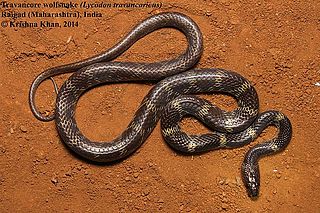
Lycodon travancoricus, commonly known as the Travancore wolf snake, is a species of colubrid snake endemic to south India.
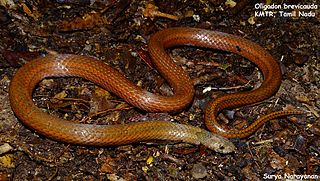
Oligodon brevicauda, the shorthead kukri snake, is a species of snake found in the Western Ghats of India.
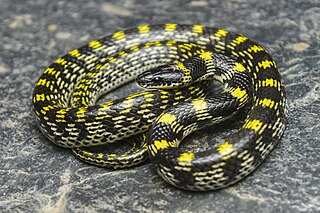
Lycodon bicolor, commonly known as the Two-coloured wolf snake, Bicolored wolf snake, or the Golden wolf snake, is a species of snake in the family Colubridae. The species is endemic to Western Himalaya.

Sibynophis sagittarius, commonly known as Cantor's black-headed snake after Theodore Cantor, is a species of snake endemic to South Asia.
Trachischium laeve, also known as the olive oriental slender snake, is a species of colubrid snake found in Nepal and Indian Himalaya.

Bungarus sindanus, the Sind krait, is a species of krait, a venomous elapid snake found in northwestern India, Afghanistan, and Pakistan. Two subspecies are recognized. It can be confused with the common krait.

Calliophis nigriscens, commonly known as the black coral snake or striped coral snake, is a species of venomous elapid snake endemic to the Western Ghats, India.
Platyplectrurus trilineatus, commonly known as the tri-striped shield-tail snake or the lined thorntail snake, is a species of uropeltid snake endemic to the Western Ghats of Southern India. Like most other shieldtail snakes, it is presumed to be a nocturnal, fossorial snake inhabiting evergreen forests. A very rare snake, about which nothing is known in terms of live colouration and natural history.
The Karnataka burrowing snake is a species of uropeltid snake endemic to India.
The purple-red earth snake is a species of nonvenomous shield tail snake, endemic to southern India. No subspecies are currently recognized.
Uropeltis beddomii, commonly known as Beddome's earth snake, is a species of snake in the family Uropeltidae. The species is endemic to India.
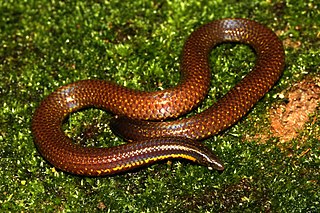
Uropeltis ellioti, commonly known as Elliot's earth snake and Elliot's shieldtail, is a species of snake in the family Uropeltidae. The species is endemic to India.
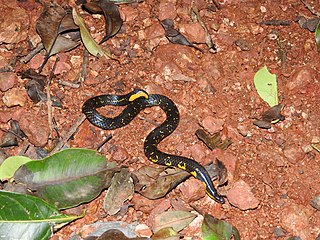
Uropeltis macrolepis, commonly known as the Bombay earth snake, the Bombay shieldtail, and the large-scaled shieldtail, is a species of snake in the family Uropeltidae. The species is endemic to southern India. There are two recognized subspecies.

Uropeltis phipsonii, commonly known as Phipson's earth snake and Phipson's shieldtail, is a species of snake in the family Uropeltidae. The species is endemic to India.

Uropeltis rubromaculata is a species of nonvenomous shieldtail snake in the family Uropeltidae. The species is endemic to southern India. There are no subspecies that are recognized as being valid.
Smith's earth snake, also known commonly as the violet shieldtail, is a species of nonvenomous snake in the family Uropeltidae. The species is endemic to India.
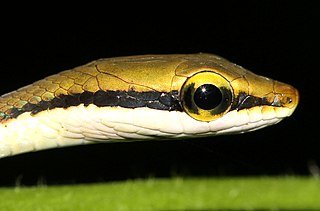
Dendrelaphis girii, Giri's bronzeback tree snake or Giri's bronzeback, is a species of diurnal, arboreal, Colubrid snake endemic to the Western Ghats of southwestern India.














